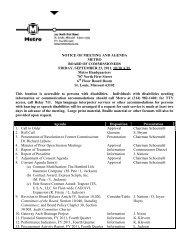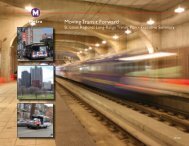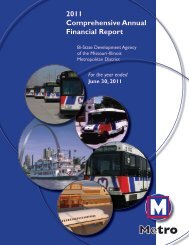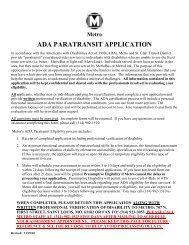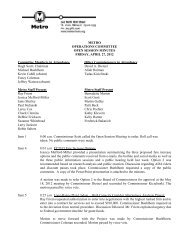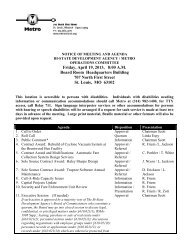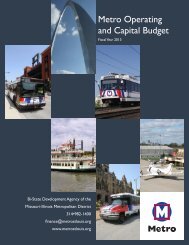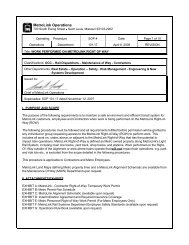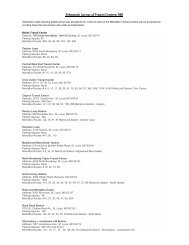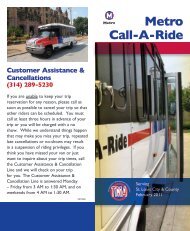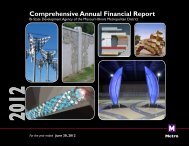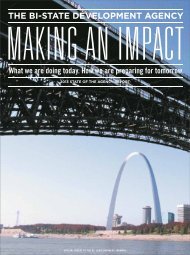st.louis regional transit -oriented development best ... - Metro Transit
st.louis regional transit -oriented development best ... - Metro Transit
st.louis regional transit -oriented development best ... - Metro Transit
You also want an ePaper? Increase the reach of your titles
YUMPU automatically turns print PDFs into web optimized ePapers that Google loves.
loans that la<strong>st</strong> for five to thirty years after the project is con<strong>st</strong>ructed. Many TOD projects also use some<br />
form of “gap financing,” such as bridge or mezzanine loans, to cover the period between con<strong>st</strong>ruction<br />
and long-term loans.<br />
POTENTIAL BARRIERS TO TOD AND OTHER CONSIDERATIONS<br />
FINANCING<br />
The hi<strong>st</strong>orically low values and prices of land in the region – a by-product of unre<strong>st</strong>rained “greenfield”<br />
<strong>development</strong> in the suburbs – exert pressure again<strong>st</strong> financing for higher-density <strong>development</strong>. Also,<br />
few of the firms that provide <strong>development</strong> financing are comfortable with the unconventional concepts<br />
and terms associated with TOD financing. This lack of familiarity with TOD makes it more difficult for<br />
developers to secure financing.<br />
DESIGN<br />
TOD is design-intensive, often requiring assemblage of multiple parcels; compliance with form-based<br />
codes and robu<strong>st</strong> design guidelines; sub<strong>st</strong>antial landscaping; and plans for supportive infra<strong>st</strong>ructure such<br />
as roads or bike trails. These factors often increase <strong>st</strong>artup co<strong>st</strong>s for initial planning and design work.<br />
PARKING<br />
Structured parking can add co<strong>st</strong>s to TOD, while innovative parking design and traffic circulation<br />
engineering may delay implementation.<br />
HOLDINGS<br />
TOD may require developers to hold property for a longer term than is usually required for single-use<br />
<strong>development</strong>—that is, for seven or ten years as opposed to five, which makes it more difficult to turn a<br />
quick profit.<br />
LIMITATIONS OF THE TRANSIT NETWORK<br />
TOD relies not only on the characteri<strong>st</strong>ics of the <strong>development</strong> area, but also on the <strong>transit</strong> connectivity<br />
of that TOD to other desirable locations within the region. If the <strong>regional</strong> <strong>transit</strong> network is limited, the<br />
attractiveness of a <strong>st</strong>ation for TOD is similarly limited.<br />
ECONOMIC DEVELOPMENT<br />
Some critics argue that proximity to <strong>transit</strong> fails to generate new economic activity, arguing in<strong>st</strong>ead that<br />
TOD simply relocates economic activity that may have occurred elsewhere under market conditions.<br />
This criticism makes it difficult for elected officials to maintain the long-term perspective necessary to<br />
support inve<strong>st</strong>ments that may take ten or more years to complete.<br />
RESISTANCE TO HIGH-DENSITY DEVELOPMENT<br />
Residents in and around a proposed TOD area will often oppose higher-density <strong>development</strong>, fearing<br />
the potential negative impacts on the exi<strong>st</strong>ing character of their neighborhood.<br />
TOD Be<strong>st</strong> Practices Guide January 14, 2011 26



